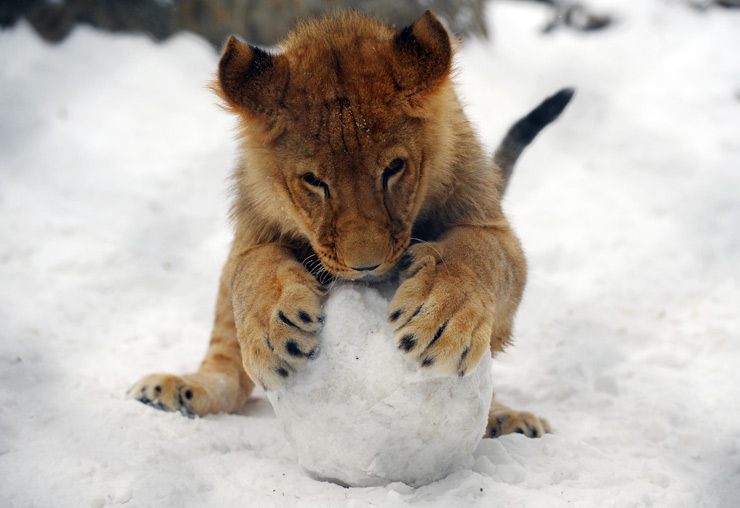Swedish zoo admits killing ‘surplus’ healthy lion cubs
Boras Djurpark defends ‘last resort’ decision to cull nine young lions since 2012

A Swedish zoo has defended its practice of euthanising healthy lion cubs deemed “surplus”.
Only two of the 13 lion cubs born since 2012 at Boras Djurpark, a wildlife park near Gothenburg which houses around 500 animals, have survived to adulthood. Two died of natural causes, while the other nine were put down despite having no health problems.
Documents seen by Swedish broadcaster STV show that a litter of four lions born in March 2012, called Simba, Nala, Sarabi and Rafiki, were euthanised as “surplus” in autumn 2013.
The Week
Escape your echo chamber. Get the facts behind the news, plus analysis from multiple perspectives.

Sign up for The Week's Free Newsletters
From our morning news briefing to a weekly Good News Newsletter, get the best of The Week delivered directly to your inbox.
From our morning news briefing to a weekly Good News Newsletter, get the best of The Week delivered directly to your inbox.
In 2015, a similar fate befell three cubs christened Kiara, Banzai and Kovu, born the previous year.
The latest litter, four cubs who were born in late 2016, have fared slightly better, the Gothenburg Post reports. On Tuesday, Potter and Weasley were put down, but their siblings Dolores and Granger have found homes at a zoo in England.
The zoo’s chief executive, Bo Kjellson, told STV that the zoo’s strategy was “no secret” and that selective euthanisation was sometimes necessary to avoid unbalancing the zoo’s carefully calibrated care and breeding programme.
The Boras Djurpark aims to give its animal occupants an environment that closely resembles their natural habitat, and Kjellson said that an excess number of lions can disrupt the pack dynamic.
A free daily email with the biggest news stories of the day – and the best features from TheWeek.com
“When the aggression in the group became too much we had to remove some animals,” he said. “We had tried to sell or relocate them to other zoos for a long time but unfortunately there were no zoos that could receive them.”
Kjellson refused to rule out any future killings of healthy lion cubs. “Currently, the group works well, but some of them may become surplus animals,” he said. "We wish we could place the animals in other zoos, but we are fully aware that killing can be the last resort.”
The zoo’s approach may come as a shock to animal lovers, but the practice of culling surplus animals is common
In 2014, Dr Lesley Dickie of the European Association of Zoos and Aquaria, told the BBC that between 3,000 and 5,000 animals are "management-euthanised" in European zoos in any given year, although large mammals make up a small fraction of this total.
The EAZA’s guidelines to zoos and conservation programmes permit euthanisia in instances “where the continued presence of an individual animal is disruptive to the natural dynamic of a group”.
-
 Cryptocurrency and the future of politics
Cryptocurrency and the future of politicsIn The Spotlight From electoral campaigns to government investments, crypto is everywhere and looks like it’s here to stay
-
 Ssh! UK libraries worth travelling for
Ssh! UK libraries worth travelling forThe Week Recommends From architectural delights to a ‘literary oasis’, these are some of the best libraries around the country
-
 A fentanyl vaccine may be on the horizon
A fentanyl vaccine may be on the horizonUnder the radar Taking a serious jab at the opioid epidemic
-
 How Bulgaria’s government fell amid mass protests
How Bulgaria’s government fell amid mass protestsThe Explainer The country’s prime minister resigned as part of the fallout
-
 Femicide: Italy’s newest crime
Femicide: Italy’s newest crimeThe Explainer Landmark law to criminalise murder of a woman as an ‘act of hatred’ or ‘subjugation’ but critics say Italy is still deeply patriarchal
-
 Brazil’s Bolsonaro behind bars after appeals run out
Brazil’s Bolsonaro behind bars after appeals run outSpeed Read He will serve 27 years in prison
-
 Americans traveling abroad face renewed criticism in the Trump era
Americans traveling abroad face renewed criticism in the Trump eraThe Explainer Some of Trump’s behavior has Americans being questioned
-
 Nigeria confused by Trump invasion threat
Nigeria confused by Trump invasion threatSpeed Read Trump has claimed the country is persecuting Christians
-
 Sanae Takaichi: Japan’s Iron Lady set to be the country’s first woman prime minister
Sanae Takaichi: Japan’s Iron Lady set to be the country’s first woman prime ministerIn the Spotlight Takaichi is a member of Japan’s conservative, nationalist Liberal Democratic Party
-
 Russia is ‘helping China’ prepare for an invasion of Taiwan
Russia is ‘helping China’ prepare for an invasion of TaiwanIn the Spotlight Russia is reportedly allowing China access to military training
-
 Interpol arrests hundreds in Africa-wide sextortion crackdown
Interpol arrests hundreds in Africa-wide sextortion crackdownIN THE SPOTLIGHT A series of stings disrupts major cybercrime operations as law enforcement estimates millions in losses from schemes designed to prey on lonely users